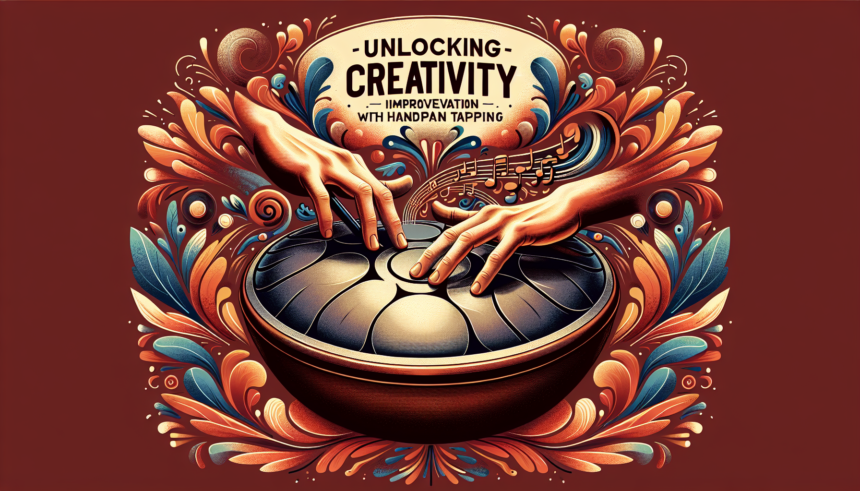<!DOCTYPE html>
<html lang="en">
<head>
<meta charset="UTF-8">
<meta name="viewport" content="width=device-width, initial-scale=1.0">
<title>Unlocking Creativity: Improvisation with Handpan Tapping</title>
<style>
body {
font-family: Arial, sans-serif;
line-height: 1.6;
margin: 20px;
}
h1, h2, h3 {
color: #2c3e50;
}
p {
color: #34495e;
}
.faqs {
margin-top: 30px;
border-top: 2px solid #ecf0f1;
padding-top: 20px;
}
.faq-item {
margin-bottom: 15px;
}
</style>
</head>
<body>
<h1>Unlocking Creativity: Improvisation with Handpan Tapping</h1>
<p>The handpan, a remarkable musical instrument that captivates both musicians and the audience, has become a popular platform for expressing creativity through music. Its hemispherical shape, central note, and perimeter of smaller notes allow for an extensive range of sound vibes and rhythms. Improvisation with handpan tapping is an intriguing venture into creativity that opens new doors for personal expression, musical discovery, and emotional resonance.</p>
<h2>The Essence of the Handpan</h2>
<p>The handpan is a relatively modern instrument, invented in the 21st century, and known for its soothing and meditative sound qualities. It is typically made from steel and consists of a central dome note surrounded by several tone fields or notes. Each handpan is uniquely tuned to a specific scale, allowing the musician to effortlessly produce harmonic and mesmerizing music.</p>
<p>Because of its distinct sound and design, the handpan invites players into a world of immediate musical invention where traditional melody and rhythm merge seamlessly with exploration and chance. Unlike many other percussion instruments, the handpan encourages a gentle yet complex approach to its playing style — making it perfect for improvisation.</p>
<h2>Improvisation: A Gateway to Creativity</h2>
<p>Improvisation in music serves as a critical tool for creative expression, allowing musicians to interact with their instruments beyond rigid compositions or written scores. Through improvisation, performers engage in spontaneous creation, which is both an emotional and intellectual process. When combined with the unique attributes of the handpan, improvisation stretches its boundaries, creating limitless possibilities for creative exploration.</p>
<p>Improvising with a handpan involves an intimate connection between the player and the instrument. This connection encourages musicians to draw from their environment, emotions, and subconscious ideas, which results in music that resonates on a deeply personal level. Each tap, stroke, and touch becomes a meaningful communication between the musician and the listener.</p>
<h2>Techniques of Handpan Tapping</h2>
<p>To begin with handpan tapping, familiarize yourself with the instrument's timbre and acoustic properties. The diverse sound palette of the handpan is a foundational element when approaching improvisation. Acknowledge the unique sounds of each note, affirm the dominance of the main tone, and understand the interval relationships between adjacent notes. Build a mental map of the handpan’s tonal layout to enhance your intuitive response during an improvisation session.</p>
<p>Handpan tapping encompasses various techniques:</p>
<ul>
<li><strong>Finger Tapping:</strong> Use your fingertips to create articulate and crisp notes.</li>
<li><strong>Thumb Tapping:</strong> Leverage the thumbs for more power and dynamic play.</li>
<li><strong>Palm Tapping:</strong> Incorporate your palms to create woofer-like bass effects.</li>
<li><strong>Dragging and Rolling:</strong> Slide or roll your fingers across the notes for melodic transitions.</li>
<li><strong>Muting:</strong> Touch the tone field lightly while tapping for subtle dampened notes.</li>
</ul>
<p>When performing these techniques, maintaining a relaxed posture and ensuring fluid hand movements is crucial. These gestures form the building blocks of your improvisation, contributing to a diverse range of rhythms and textures.</p>
<h2>Channeling Emotions Through Handpan</h2>
<p>Improvisation with a handpan often embodies the player’s emotional state. The instrument’s melodic tones and ability to seamlessly transition between chords provide a canvas to manifest one's feelings and thoughts. This process of channeling emotions into sounds allows for deep personal reflection and communication.</p>
<p>Musicians may use the instrument to convey serenity or excitement, solitude or connection, which in return helps shape their creative output. The meditative quality intrinsic to the handpan's sounds makes it a fitting companion for expressing and exploring emotions artistically.</p>
<h2>Exploring New Musical Horizons</h2>
<p>Handpan players widely use improvisation as a means of traveling through uncharted musical territories. When improvising, let innovation guide you by combining different hand techniques, exploring unconventional scales, and adjusting your playing dynamics. This allows the music to take prophetic forms, influenced by momentary impulses and creativity. Discovering unanticipated chords or patterns often leads to novel compositions, broadening both one's music repertoire and philosophical outlook.</p>
<p>Furthermore, the handpan is receptive to fusion genres, so don't hesitate to incorporate elements from jazz, ambient, or world music. Each genre injects new colors and traits into the music, creating a rich and complex auditory experience.</p>
<h2>Collaboration and Improvisation</h2>
<p>Just as improvisation nurtures individuality, it also fosters collaborative genius. More musicians are including the handpan in ensemble settings, interacting with other instruments like guitars, flutes, and percussive elements. This interaction is not only extraordinarily dynamic but also a powerful form of shared creativity. The distinct tones of the handpan complement other instruments beautifully, set within various musical genres.</p>
<p>Collaborative improvisation is exhilarating as it demands acute listening, empathy, and seamless interaction between musicians, enriching the music and performance experience. It promotes unique dialogues where ideas flow freely between performers who echo and reform each other’s concepts endlessly.</p>
<h2>Conclusion</h2>
<p>In conclusion, improvisation with handpan tapping offers a profound and transformative musical experience. It provides musicians with a voice straight from their souls, unhindered by preconceived constraints. By embracing the handpan's distinctive qualities, musicians can delve into. It facilitates a harmony between the instinctive and the intellectual—unlocking profound creativity and connecting uniquely with listeners. Whether playing solo or in combination with others, the handpan offers a vast avenue for exploration, freedom, and expression in the realm of music improvisation.</p>
<div class="faqs">
<h2>Frequently Asked Questions (FAQs)</h2>
<div class="faq-item">
<h3>1. What is a handpan, and how does it differ from steel drums?</h3>
<p>A handpan is a musical instrument made of steel, shaped like a dome with a central note surrounded by several tone fields. Unlike steel drums, which originate from Trinidad and Tobago and are typically played with mallets, the handpan is played with hands and has a more delicate, meditative sound quality.</p>
</div>
<div class="faq-item">
<h3>2. Is prior musical training necessary to play the handpan?</h3>
<p>No, prior musical training isn't necessary to play the handpan. While musical experience can enhance your understanding of the instrument, its intuitive design allows beginners to explore and produce beautiful music through practice and experimentation.</p>
</div>
<div class="faq-item">
<h3>3. Can handpan improvisation help in relieving stress?</h3>
<p>Yes, handpan improvisation is an excellent way to relieve stress. Its soothing and tranquil sound can lead to relaxation and meditation, while the act of playing provides a mindful, cathartic experience that can help alleviate anxiety and improve emotional well-being.</p>
</div>
<div class="faq-item">
<h3>4. How do I choose the right handpan for improvisation?</h3>
<p>Choosing the right handpan depends on your musical preferences, budget, and design attributes. Consider the scale and sound quality you prefer, ensuring the handpan is well-tuned and made by a reputable manufacturer. Listening to various scales online or in person may help make the decision easier.</p>
</div>
<div class="faq-item">
<h3>5. Can I combine handpan music with digital music production?</h3>
<p>Absolutely. The handpan's sound can blend seamlessly into digital music productions. By recording the handpan using proper audio equipment, you can incorporate its unique sound into digital tracks, loops, or soundscapes for a modern twist on your musical creations.</p>
</div>
</div>
</body>
</html>Unlocking Creativity: Improvisation with Handpan Tapping

Leave a comment




